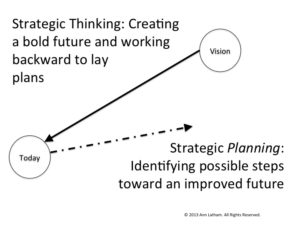Strategic planning isn’t always strategic.
Why? Let me count the ways!
1. Strategic planning is usually mired in today’s circumstances.
And it stays there thanks to tools like SWOT. SWOT immerses the planners in obstacles and current perceptions. It makes opportunities no more important than strengths, weaknesses, and threats.
Your future is all about opportunity. You build strengths to take advantage of opportunities. You overcome weaknesses to take advantage of opportunities. You choose the opportunities to make the threats less relevant.
Don’t let strengths, weaknesses, and threats overpower opportunities by treating them as equals. Concentrate first and foremost on the opportunities! Focus on creating value for which customers are willing to pay!
2. Strategic Planning is an oxymoron.
Strategy is not planning. Strategic thinking establishes the destination and planning establishes the actions needed to reach that destination. When you conflate the two, planning wins and strategy loses. Instead of pursuing a compelling vision, all you get is incremental progress in the same general direction you’ve been headed all along.
When you strategize, you create an eye-opening vision. You shift perceptions so you can think differently and see opportunities that you probably couldn’t see when you began.
Once you’ve got that vision, you work backwards to establish a path. You find ways to leap obstacles. You transcend threats. You surpass incremental plans. You barely notice constraints that leave ‘strategic planners’ hog-tied.
If you want significant success, you absolutely must separate strategic positioning from planning.
3. Strategy is tackled by people who aren’t strategic.
I’ve seen this mistake too many times. It is especially common for non-profits. If your board and staff aren’t very strategic and you create a strategic planning committee from board volunteers and top staff members, your committee is not going to be strategic. I’ve helped these groups overcome their non-strategic penchant for concrete, tactical, short-term, conservative action, but let me tell you, developing a strong strategy is much easier and more effective if you start with strategic thinkers.
4. Your strategic thinking is driven by the calendar, not need.
I’m frequently asked how often an organization should do strategic planning. Every five years? Three years? Annually? More often than that?
The answer is none of the above. What does the calendar have to do with strategy? If you are driven by the calendar, you aren’t being strategic. As to the frequency question? Your strategy is based on assumptions you’ve made about your environment and your performance. The day those underlying assumptions prove false is the day you need to revisit your strategy.
So:
- Separate strategic positioning from planning.
- Use a process that lifts you out of your current paradigm and daily grind.
- Involve good strategic thinkers.
- Review your strategic assumptions monthly so you know when it is time to reposition.
The alternative is boring mediocrity at best.


Comments are closed.